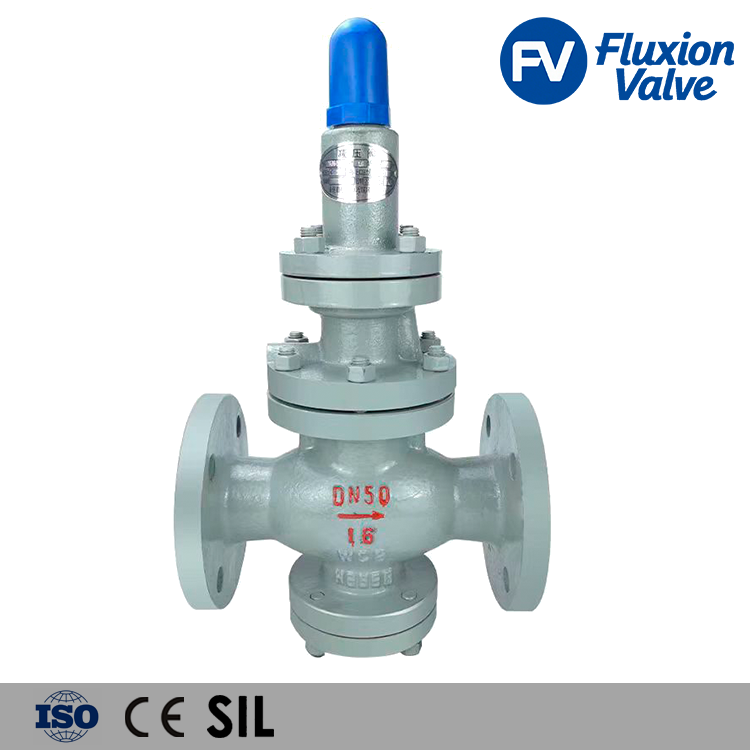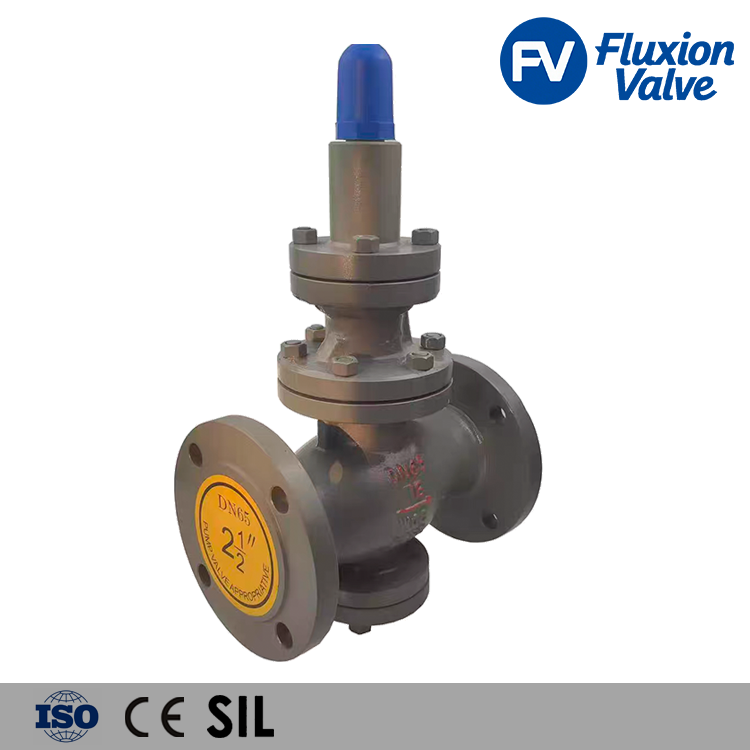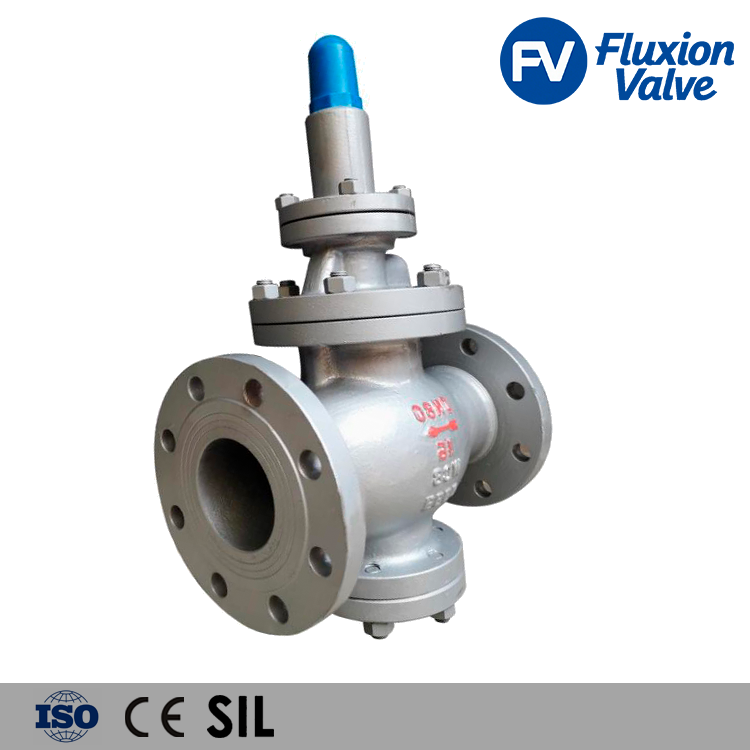XPS24 Pressure-Reducing Valve | Reliable Steam Pressure Control
Size Range :DN15-DN500
Temperature Rating :-20~450℃
Pressure Rating :PN1.6Mpa – PN16Mpa
End Connection :RF Flange / FF Flange
Valve Material :WCB, CF8, CF8M
Seal Material :Metal-to-Metal
Acting Type :Pilot Operated
Regulating Structure :Piston and Spring Type
Application :Suitable for steam pressure reducing.
Description:
The XPS24 piston-type steam pressure-reducing valve is a pilot-operated pressure reducer , and it designs to effectively reduce and stabilize pressure within steam pipelines. This valve is specifically engineered to ensure consistent performance and reliability in steam systems.
Working Principle of Pressure-reducing valve
The XPS24 operates by utilizing a diaphragm and spring-based mechanism to precisely adjust and control pressure reduction and stabilization:
1.Pressure Adjustment: The outlet pressure set by calibrating the adjusting spring.
2.Diaphragm Sensing: The diaphragm senses changes in outlet pressure.
3.Pilot Valve Operation: Fluctuations in outlet pressure cause the pilot valve to open and close accordingly.
4.Main Valve Regulation: This drives the piston to adjust the throttling area of the main valve. It achieves the desired pressure reduction.
5.Fluid Dynamics: By adjusting the throttling area, fluid velocity and kinetic energy changed, causing pressure loss and ensuring effective pressure control.
6.Stabilization: The system balances downstream pressure fluctuations with spring force to maintain stable output pressure.
The XPS24 piston-type steam pressure-reducing valve represents a reliable solution for steam systems requiring accurate pressure control and stabilization. Its robust design, coupled with high responsiveness and ease of maintenance, makes it an ideal choice for industrial applications.
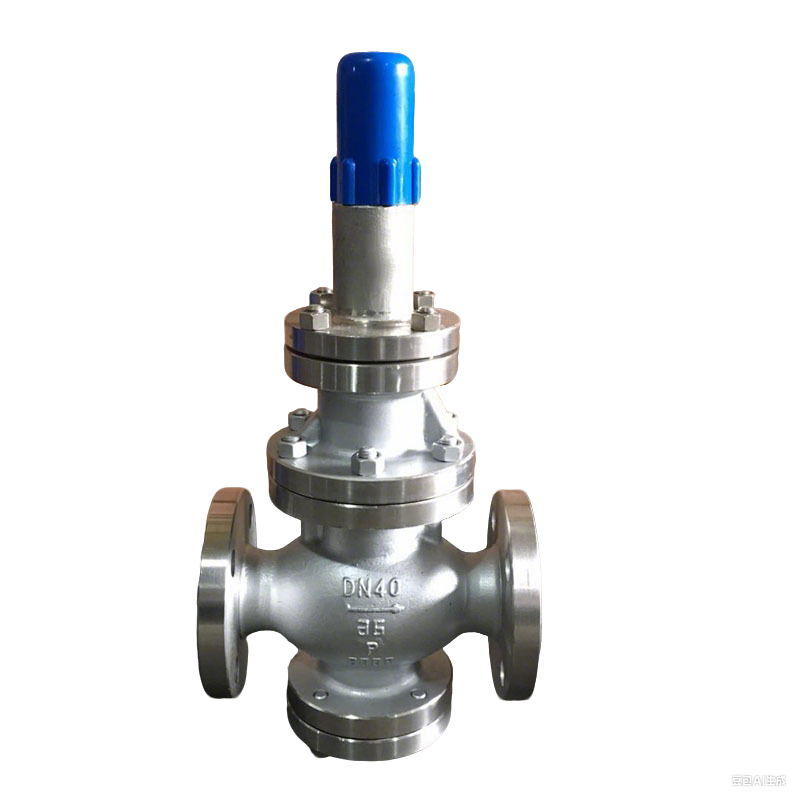
How pressure-reducing valve Works
The XPS24 valve operates using a diaphragm and spring-based mechanism to ensure precise pressure reduction and stabilization. The outlet pressure can set by calibrating the adjusting spring, while the diaphragm detects changes in outlet pressure. These fluctuations prompt the pilot valve to open or close as needed. In turn, it drives the piston to modify the throttling area of the main valve. This adjustment regulates fluid velocity and kinetic energy, resulting in controlled pressure reduction.
To maintain steady output pressure, the system balances downstream pressure variations with the force exerted by the spring. This process enables the XPS24 to effectively manage fluid dynamics, minimizing pressure loss and ensuring consistent performance. The interaction between the diaphragm, pilot valve, and main valve ensures that the required pressure levels are achieving and maintaining with high precision.
Main Parameter
| Main Parameter | Unit | PN16 | PN25 | PN40 | PN64 | PN100 | PN160 | ||
|---|---|---|---|---|---|---|---|---|---|
| Norminal Pressure | Mpa | 1.6 | 2.5 | 4 | 6.4 | 10 | 16 | ||
| Shell Testing Pressure | Mpa | 2.4 | 3.75 | 6 | 9.6 | 15 | 24 | ||
| Seal Testing Pressure | Mpa | 1.6 | 2.5 | 4 | 6.4 | 10 | 16 | ||
| Inlet Max. Allowed Pressure | Mpa | 1.6 | 2.5 | 4 | 6.4 | 10 | 16 | ||
| Outlet Pressure Range | Mpa | 0.1-1.0 | 0.1-1.6 | 0.1-2.5 | 0.5-3.5 | 0.5-3.5 |
0.5-4.5 |
||
| Pressure Characteristic Deviation△P2P | Mpa | Less than 5% of Outlet Pressure | |||||||
| Flowrate Characteristic Deviation△P2G | Mpa | Not more than 10% of Outlet Pressure | |||||||
| Min. Allowed Pressure Difference △P | Mpa | 0.15 | 0.15 | 0.2 | 0.4 | 0.8 | 1 | ||
| Leakage Rate | Class IV | ||||||||
Valve CV Value
| Valve Size | 15 | 20 | 25 | 32 | 40 | 50 | 65 | 80 | 100 | 125 | 150 | 200 | 250 | 300 | 350 | 400 | 500 |
|---|---|---|---|---|---|---|---|---|---|---|---|---|---|---|---|---|---|
| Cv Value | 1 | 2.5 | 4 | 6.5 | 9 | 16 | 25 | 36 | 64 | 100 | 140 | 250 | 400 | 570 | 780 | 1020 | 1500 |
Structure and Dimensions
Main Parts and Material
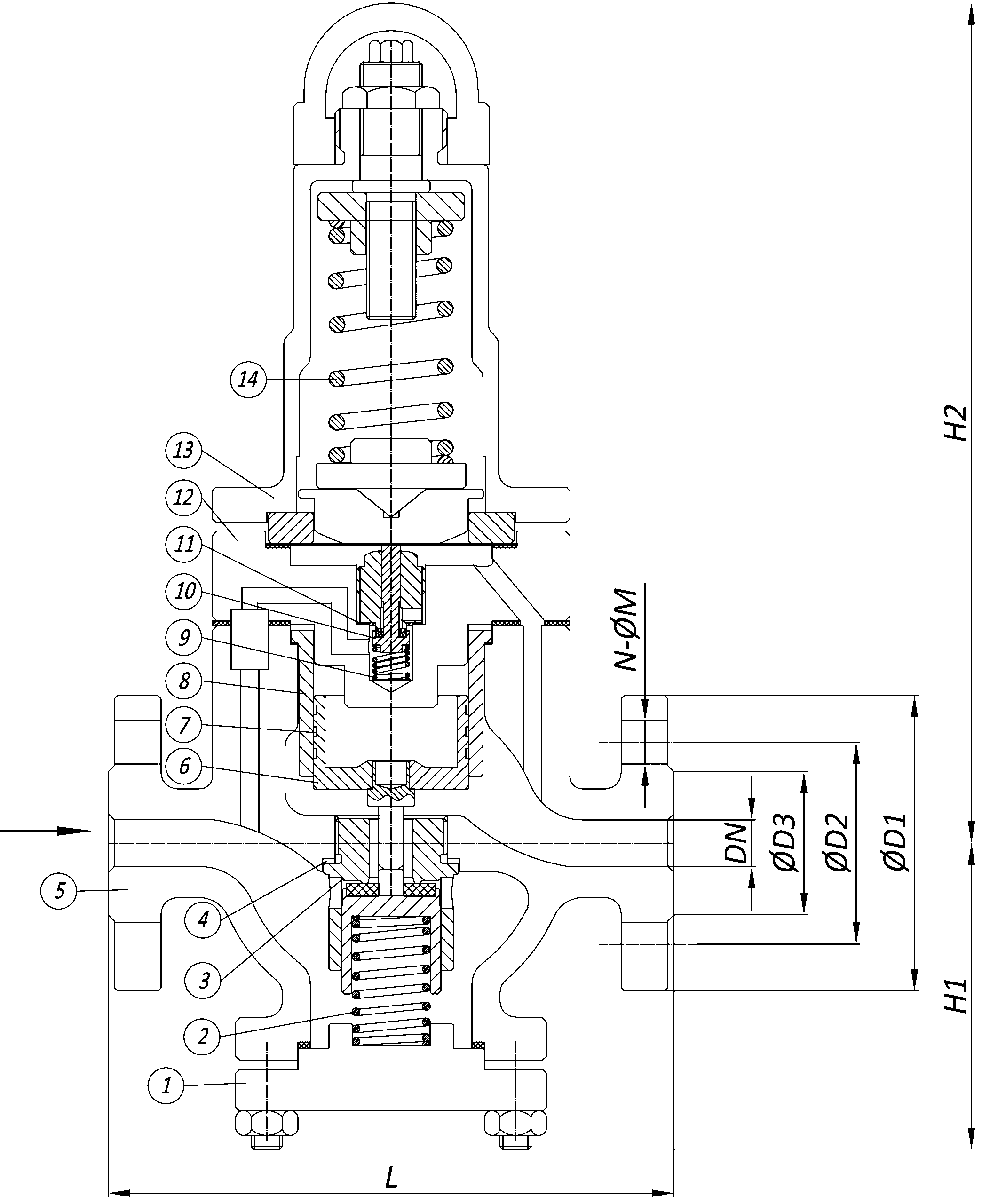
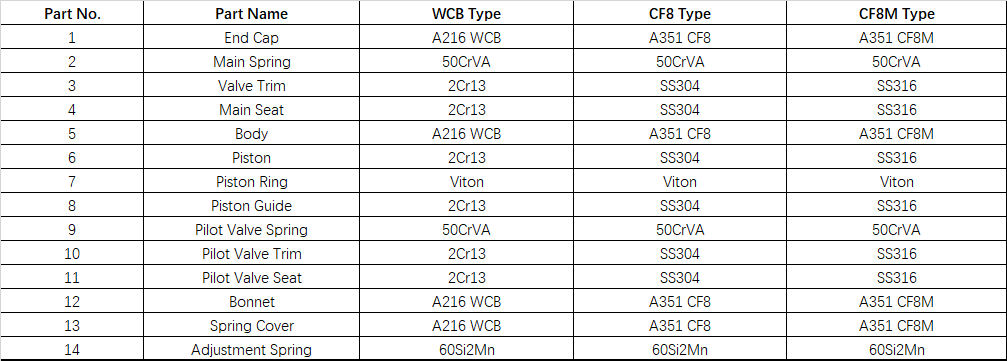
Main Dimensions

Advantages of XPS24 Pilot Operated Piston Type Steam Pressure-Reducing Valve
a.Highly Responsive Operation
Features exceptional sensitivity to pressure changes, enabling the valve to detect and react swiftly to any variations within the system.
Delivers accurate pressure management for balanced and efficient operation.
Maintains consistent and reliable performance, whether dealing with minor or significant system pressure fluctuations.
b.Precision Control by pressure-reducing valve
Allows for precise adjustment of the main valve’s opening and closing, resulting in stable output pressure.
Minimizes disruptions in steam delivery through careful valve regulation.
Reduces energy waste and contributes to cost-effective, smooth operations.
c.Superior Sealing
Incorporates high-performance sealing rings and valve seats designed to minimize the risk of steam leakage.
Preserves energy efficiency and reduces potential downtime related to maintenance of leaking components.
Reinforces system reliability and positions the XPS24 as a trusted asset in steam networks.
d.Maintenance-Friendly Design
Engineered with a simple and intuitive structure, making maintenance procedures more accessible and less complex.
Cuts down on maintenance complexity and system downtime.
Facilitates quicker servicing and extends operational periods between required maintenance.
e.Outstanding Durability
Constructed from premium-quality materials to withstand rigorous operational demands and harsh environmental conditions.
Offers reliable, long-lasting performance even in high-pressure settings.
The robust design minimizes wear, extending both the service life of the valve and the reliability of the overall system.
These comprehensive advantages make the XPS24 valve an essential solution for businesses focused on achieving efficiency, stability, and long-term operational excellence in steam systems.
FAQs
1. How does a pilot operated pressure reducing valve work?
This type of valve uses a pilot mechanism to reduce inlet steam pressure to the desired outlet pressure automatically. A piston, controlled by the pilot valve, adjusts its position in response to the inlet pressure and the set outlet pressure range. This process ensures precise and stable pressure control in steam systems.
________________________________________
2.What is a pilot operated pressure relief valve?
A pilot operated pressure relief valve (PRV) functions similarly to a reducing valve but primarily serves to maintain safety in the system by releasing excess pressure. When the pressure exceeds the preset limit, the pilot mechanism opens the valve to release excess steam or gas, preventing potential damage to the system.
________________________________________
3.What is the difference between direct acting and pilot-operated PRV?
The main difference lies in their operation:
•Direct Acting PRV: The valve relies on the force of the spring to counterbalance the steam pressure, adjusting directly to pressure changes. It’s suitable for lower-capacity systems.
•Pilot-Operated PRV: A pilot valve works in tandem with the main valve, utilizing controlled feedback to adjust the outlet pressure. This ensures greater precision, making it ideal for high-capacity and high-pressure systems.
________________________________________
4.Are PSV and PRV the same thing?
No, they are not the same. While both ensure system safety, their functions differ:
•PRV (Pressure Reducing Valve) decreases high pressure to a specific lower outlet pressure for operational purposes.
•PSV (Pressure Safety Valve) is designed to release excess pressure to protect the system from overpressure conditions that could lead to failure.

We Focus on Below Quality:
★ Material Analysis ★
★Precision Engineering★
★Customizable Solutions★
★Comprehensive Support★
★Products Inspection★
★Pressure Testing★
Products Catagray
Piston Type PRV
PX220 Pilot Type Diaphragm Type PRV
PX220 Pilot Type Diaphragm Type PRV
Diaphragm Type PRV
PX220 Pilot Type Diaphragm Type PRV
PX221 Pilot Type Diaphragm Type PRV
PX230 Pilot Type Diaphragm Type PRV
Steam Trap
HS732 Floating Type Steam Trap
HS732 Floating Type Steam Trap
Trunnion Ball Valve
About Us
News
Contact Us
Social Media
Send Your Request Here
Related products
-
Piston Type Pressure Reducing Valve
XPS34 Pressure Reducing Valve | High Sensitivity Steam PRV
-
Uncategorized
Timeless Classic Collection
-
Uncategorized
Urban Chic Ensemble
-
Uncategorized
Bohemian Rhapsody Attire

